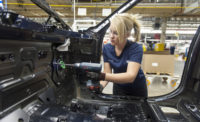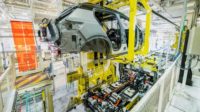During the recent Tokyo Auto Show, green vehicles stole the spotlight. Honda, Nissan, Toyota and Volkswagen unveiled state-of-the-art technology. BMW and Toyota recently announced a joint-venture to develop a new generation of lithium-ion batteries for EV applications. And, not to be outdone, Ford Motor Co. and General Motors Co. are expected to unveil a number of parallel hybrids this year.
By the end of 2016, J.D. Power and Associates predicts there will be 159 hybrid and electric vehicle models available for purchase in the United States—a significant increase from 31 models in 2009. In fact, a recent report from Pike Research claims that HEVs and plug-in electric vehicles (PEVs) will account for 5.1 percent of total U.S. vehicle sales in 2017.
“Production of electrified vehicles is gearing up all over the world,” says Dave Hurst, a senior analyst at Pike Research. “Automakers around the world will introduce dozens of new models over the next few years, fueling consumer interest and increasing sales of electric vehicles as a percentage of total auto sales. The EV market will grow at a rapid clip in the next six years—at a rate of nearly 20 percent a year, compared to fewer than 4 percent for the worldwide market for vehicles of all kinds.”
Hybrid technology is important for automakers to meet legislative requirements for fuel economy and carbon dioxide emissions. However, the industry still faces the challenge of cost-effectively mass-producing high-quality batteries.
“The common goal of every hybrid vehicle is to produce fuel economy benefits to the consumer through the addition of an electrical system that reduces or eliminates the dependence on the internal combustion engine,” says Randy Sumner, director of global hybrid vehicle development at Delphi Corp. “Unique electrical requirements of connection systems and wiring must be taken into account when designing and developing a hybrid electric vehicle.”
Today’s hybrid vehicles range from the simple belt alternator starter, 14-volt stop-start system to fully electric systems capable of driving a vehicle with a battery pack and electric motor alone. In addition to batteries, the drive systems of these vehicles consist of electric motors and inverters connected by AC and DC wiring harnesses.
“Hybrid vehicles present unique challenges when it comes to electrical and electronic architecture,” claims Sumner. “They have rigorous power requirements and demand robust component performance and additional safety features, due to the challenging environment in which they operate. Battery packs, DC-DC converters, drive motors, and electrical and electronic systems capable of managing high voltage and currents (600 volts and higher) are increasingly sophisticated.”
“Hybrids need more cables and wires [than] other cars,” adds Helmut Kalb, vice president of electromobility at Leoni AG. “In addition to the conventional 12-volt vehicle electrical system, they need a high-voltage wire set for the electrical drivetrain. Electrified power trains require cables and components [that address] conductivity, mechanical flexibility, thermal capacity and safety.”
WIRE PROCESSING ISSUES
Electric vehicle wiring is similar to battery cables in conventional vehicles, except that EV cables are shielded. “The shield is typically foil covered by a tinned-copper braided shield,” says Pete Doyon, vice president of product development at Schleuniger Inc. “The shielding is required to reduce electromagnetic and radio frequency interference (EMI/RFI) caused by the electrical noise generated by the high frequency switching that takes place in the inverter.”
In traditional vehicles, the most cost-effective method of suppressing EMI/RFI noise is through the use of components such as capacitors, inductors and diodes. But, shielding electronics and wiring becomes a more cost-effective solution in HEVs because the traditional suppression components required would be too large and heavy to be practical.
Automakers and suppliers typically shield cable by adding a wrapping, such as a metal foil or a braided wire mesh around it to contain the interference. “Hybrid vehicle technology will continually change, and as this happens, the need for shielded cable will become increasingly important,” says Sumner. “Automakers will continue to need to use electronics for weight and cost savings and, as a result, they will continue to need to reduce the noise generated by those electronics.”
To cut braided shield cleanly, a rotary stripping head is required to make the incision. “It is very important that the layer of insulation underneath the braided shield and foil is not nicked or otherwise damaged,” warns Doyon. “The rotary stripping head requires a centering system to properly guide the cable while the rotary incision is being made.”
The larger cable sizes associated with HEVs also demand more robust processing equipment. “Large, heavy reels require a powered dereeler for loading, unloading and feeding the cable to downstream processing equipment,” explains Doyon. “Heavy-duty cutting and stripping machines are required to measure, cut and strip the cable. Crimping is usually done in a semiautomatic process after the cables are cut to length and stripped.”
Engineers are also focusing on connectors. “A key component in high-voltage electrical wiring harnesses is the connection system,” says Sumner. “Special attention must be paid to the design of the high-power connections.”
Two areas must be addressed in high-voltage connection systems design in regards to safety: The hazardous voltage interlock loop (HVIL) and the environmental sealing of connectors to protect against short circuiting between high-voltage terminals when the vehicle is in use.
Sealing high-voltage connections is critical, due to the failure modes which may result when connections are left unsealed, such as short circuits. “Using silicone cable and connector peripheral seals, the connections are sealed to make sure moisture cannot enter and create a thermal incident or fire,” explains Sumner. “High-voltage systems require more robust sealing than traditional 12-volt systems because the higher the voltage, the higher the potential for arcing.
“The HVIL is a feature of high-power connection systems necessary to protect against arcing that could occur if the connectors used in the power electronics are pulled apart too quickly,” Sumner points out. “It communicates that a disconnection was made and sends a signal to safely shut down power. This becomes necessary in the event of an accident or if a technician needs to disconnect power to service the vehicle.”
LACK OF STANDARDS
Another challenge facing engineers is a lack of industry-wide agreement on hybrid electric wiring systems. “There’s no universal standard, which creates problems,” says Sumner. “Some electrical systems are custom built with lots of part numbers. The absence of standards is preventing some companies from investing in new wire processing tools and equipment.”
“The lack of agreement among OEMs over voltage levels has been holding back progress,” adds Ian Riches, director of the global automotive practice at Strategy Analytics Inc. “Audi, BMW, Daimler, Porsche and Volkswagen agreed earlier this year on a 48-volt standard. That will help, especially at the very mild hybrid end of the market where that may be the highest voltage level required. Above that, however, no standard has yet emerged.”
Most standards activity so far has focused on electric vehicle infrastructure. For instance, Underwriters Laboratories has developed several standards that apply to EV charging systems and equipment, including cables and connectors, such as UL 62 and UL 2202.
Other standards are slowly emerging. Federal Motor Vehicle Safety Standard 305, which took effect on Sept. 1, 2011, re-quires manufacturers of HEVs to ensure that, in the event of an impact, the electrical energy storage, conversion and traction systems do not threaten the safety of the vehicle occupants. Either the systems must be electrically isolated from the vehicle’s chassis or their voltage must be below specified levels that are considered safe from electric shock hazards.
To address this issue, engineers at Federal-Mogul Corp. recently developed a new material that surrounds and protects high-voltage electrical cables, keeping the electrical system isolated from the rest of the vehicle. CrushShield encases the wire harness so that the battery cable remains isolated from the conducting structure of the vehicle.
“CrushShield incorporates a rugged, multi-layer fabric with a unique substrate design, which together absorbs and disperses energy,” claims Ramzi Hermiz, senior vice president of vehicle safety and protection at Federal-Mogul. “Its construction helps manufacturers of existing hybrid and electric vehicle models meet the new regulations without requiring electrical component or wiring redesign.”








